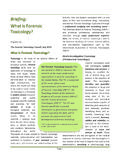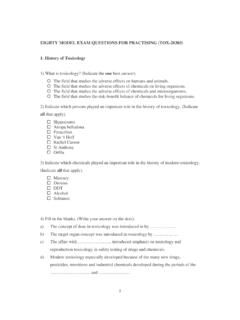Transcription of Toxicology in the 21st Century - US EPA
1 1 UNITED STATES FEDERAL GOVERNMENT COLLABORATION Toxicology IN THE 21st Century (TOX21) TESTING THOUSANDS OF ENVIRONMENTAL CHEMICALS USING NON-ANIMAL METHODS Overview Toxicology in the 21st Century (Tox21) is a US federal research collaboration that is developing alternative, non-animal methods to quickly and efficiently test thousands of chemicals for potential health effects. These approaches use advances in robotics technology to test chemicals for their potential to disrupt processes in the human body, which may lead to negative health effects. Since its formation in 2008, Tox21 has screened approximately 10,000 chemicals in more than 70 rapid tests called qualitative high-throughput screening assays . This includes chemicals used in industrial processes and consumer products as well as food additives, approved and investigational drugs, and chemical mixtures.
2 Accomplishments Tox21 methods inform policy and regulatory decisions made about the safety of chemicals US EPA s Endocrine DisruptionScreening Program (EDSP) isusing Tox21 assays as part of apanel of 18 high-throughputscreening assays that measureactivity across different parts of theestrogen receptor pathway. Theresults from the panel of 18 testsare incorporated into acomputational model to identifychemicals that have the potentialfor estrogenic activity which couldlead to endocrine computational model and assays have been reviewed by a Scientific Advisory Panel and were accepted as alternative tests within the current EDSP Tier 1 testing requirements. The European ChemicalsAgency s document Scenarios tobe implemented for searching forpotential substances of concern highlights Tox21 assays that canbe used for identifying potentialendocrine disrupting chemicals.
3 The California EnvironmentalProtection Agency hasincorporated Tox21 data in selectpesticide assessments, and theMinnesota Department of Health isusing Tox21 data for assessinghealth risks associated with watercontaminants. The World Health Organization sInternational Agency for Researchon Cancer (IARC) has used Tox21data as one area of evidencewithin a larger framework forassessing the evidence ofcarcinogenesis. Companies are using Tox21datawhen they submit Europeanchemical registration acceptance of Tox21 methods by the scientific community Tox21 has published over 200 scientific peer-reviewed articles in approximately 55 journals. Articles were most frequently published in Toxicological Sciences, Environmental Health Perspectives, Chemical Research in Toxicology , and Environmental Science and Technology.
4 The top 5 Tox21 articles have been cited an average of more than 100 times. Over 80 Tox21 publications have been cited in National Academy of Sciences Reports. 2 Millions of Tox21 data points are publicly available to inform science and decisions Tox21 has screened thousands ofchemicals in approximately 70high-throughput assays coveringover 125 important processes inthe body and generating more than70 million data points. The Tox21 data is publiclyavailable through the NationalLibrary of Medicine s PubChem,the EPA's Computational Toxicology Dashboard and NTP s Chemical Effects in Biological Systems. Detailed assay annotations,protocols, and performancestatistics are publicly available onthe EPA's ComputationalToxicology website ( ) and the NIH tripod website( ). Strategic Vision for the Next Five YearsThe predominant research activities of the Tox21 collaboration have been developing and applying high-throughput screening to toxicity testing.
5 In 2017, the Tox21 collaborators developed a new strategic vision and operational plan that broadened the scope of the collaboration to include other emerging Toxicology approaches and a focus on incorporating these scientific advances into policy and regulatory decisions. The primary goal of the Tox21 collaboration remains focused on developing new tools and methods that more efficiently and reliably predict whether a chemical might be toxic to humans. Further development and usage of these approaches will continue to significantly reduce the use of animals for chemical testing and provide data to better protect public health. Research activities under the new strategic vision and operational plan will be focused on the following areas: 1. Developing and deployingalternative test systems that arepredictive of human toxicity anddose Addressing key technicallimitations of current high-throughput screening Consolidating chemical librarymanagement and developingmore focused Curating and characterizinglegacy animal toxicity studies forcontinued comparison to high-throughput screening Validating high-throughputassays, integrated assaybatteries, computational models,3-D organ-like model systems,and other emerging Refining and deploying high-throughput methods forcharacterizing pharmacokineticsto better predict the relationshipbetween target tissueconcentrations and externaldoses of The Tox21 collaboration was formalized in 2008 through a memorandum of understanding (MOU)
6 Between the National Institutes of Health, including the National Toxicology Program (NTP) and National Human Genome Research Institute's National Chemical Genomics Center (NCGC, now a part of NCATS), and the EPA s National Center for Computational Toxicology . The Food and Drug Administration (FDA) joined the Tox21 collaboration in 2010. More information available August 2017














